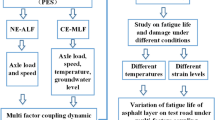Abstract
A three dimensional finite element program incorporating actually measured vertical tire-pavement contact pressure (TPCP) was utilized for modeling the mechanistic responses in asphalt concrete (AC) layers by simulating various vehicle motions: stationary and non-stationary (i.e. in acceleration or deceleration mode). Analysis of the results indicated the following items. 1) It is critical to use the vertical TPCP as the design control criteria for the tensile strains at the bottom of the AC layer when the base layer modulus is lower in magnitude (e.g. ≤400 MPa); however, when the base layer modulus is higher in magnitude (e.g. ≥7 000 MPa), the horizontal TPCP and the tensile strains in the X-direction at the surface of the AC layer should also be considered as part of the design response criteria. 2) The definition of “overload” needs to be revised to include tire pressure over-inflation, i.e., a vehicle should be considered to be overloaded if the wheel load exceeds the specification and/or the tire inflation pressure is higher than the specification. 3) Light trucks have more structural impact on the strain responses and pavement design when the thickness of the surfacing AC layer is thinner (e.g. ≤50 mm). 4) The acceleration of a vehicle does not significantly impact the AC surface distresses such as rutting at the top of the upgrade slopes or intersections; however, vehicle deceleration can dramatically induce horizontal shear strains and consequently, aggravate shoving and rutting problems at the highway intersections. Evidently, these factors should be taken into account during mechanistic stress-strain modeling and structural design of asphalt pavements.
Similar content being viewed by others
References
YOO P J, AL-QADI I L, ELSEIFI M A, JANAJREH I. Flexible pavement responses to different loading amplitudes considering layer interface conditions and lateral shear forces [J]. International Journal of Pavement Engineering, 2006, 7(1): 73–86.
HUANG Y H. Pavement analysis and design [M]. Englewood Cliffs, NJ: Prentice Hall Inc, 1993: 158–162.
MYERS L A, ROQUE R B, RUTH E. Measurement of contact stresses for different truck tire types to evaluate their influence on near-surface cracking and rutting [J]. Journal of the Transportation Research Board, 1999(1320): 175–184.
HU Xiao-di. Measuring distribution of tire ground pressure and stress response analysis of asphalt pavement using those results [D]. Shanghai: Tongji University, 2003. (in Chinese)
SIDDHARTHAN R V, KRISHNAMENON N, EL-MOUSLY M, SEBAALY P E. Investigation of tire contact stress distributions on pavement response [J]. Journal of Transportation Engineering, 2002, 28: 136–144.
de BEER M, FISHER C, JOOSTE F J. Determination of pneumatic tyre/pavement interface contact stresses under moving loads and some effects on pavements with thin asphalt surfacing layers [C]// Proceedings of the Eighth International Conference on Asphalt Pavements. Seattle, WA, 1996: 179–227.
AL-QADI I L, YOO P J. Effect of surface tangential contact stress on flexible pavement response [J]. Journal of the Association of Asphalt Paving Technologists, 2007, 76: 558–582.
AL-QADI I L, LOULIZI A, ELSEIFI M A, LAHOUAR S. The Virginia smart road: The impact of pavement instrumentation on understanding pavement performance [J]. Journal of the Association of Asphalt Paving Technologists, 2004, 73: 427–466.
SOON S C, DRESCHER A, STOLARSKI H. Tire-induced surface stresses in flexible pavements [J]. Journal of Transportation Research Record, 2003(1896): 170–176.
ANSYS 9.0 USER MANUAL [Z]. Canonsburg, PA: Ansys Inc, 2004.
HU X D, WALUBITA L F. Modeling tensile strain response in asphalt pavements: Bottom-up and/or top-down fatigue crack initiation [J]. Journal of Road Materials and Pavement Design, 2008, 10(1): 125–154.
WANG F, MACHEMEHL R B. Mechanistic-empirical study of effects of truck tire pressure on pavement [J]. Journal of the Transportation Research Board, 2006(1947): 136–145.
HU X D, ZHOU F J, SCULLION T, WALUBITA L F. Proposed loading wave forms and loading time equations for m-e pavement design and analysis [J]. Journal of Transportation Research Board, 2009: CD-ROM.
ZHUANG Ji-de. Technical of automobile tires [M]. Beijing: Press of Beijing Institute of Technology, 1996. (in Chinese)
HUHTALA M, PIHLAJAMAKI J, PIENIMAKI M. Effects of tires and tire pressures on road pavements [J]. Journal of the Transportation Research Board, 1989(1227): 107–114.
SUN Li-jun, HU Xiao-di, and BI Yu-feng. Top-down cracking analysis and control for asphalt pavements [C]// 10th International Conference on Asphalt Pavement. Québec, Canada. 2006, CD-ROM.
WALUBITA L F, SCULLION S. Perpetual pavements in Texas: The fort worth SH 114 perpetual pavement in wise county [R]. Technical Report FHWA/TX-05/0-4822-2, TTI, TX, US, 2007.
HUANG Wen-yuan. The primary research of equivalent factor of overloaded axle on asphalt pavement [J]. Journal of Highway and Transportation Research and Development, 2000, 25(1): 151–156. (in Chinese)
WANG F, INMAM R F, MACHEMEHL R B, ZHANG Z, WALTON C M. A survey study of current pavement-related truck characteristics in Texas [C]// Proc 30th Annual Canadian Society of Civil Engineering Conference. Montreal, Quebec, Canada, 2002, CD-ROM
The detection specification for apply the brake of China [S]. China Communication Press, 1980: 35–37. (in Chinese)
Author information
Authors and Affiliations
Corresponding author
Rights and permissions
About this article
Cite this article
Hu, Xd., Walubita, L.F. Modeling mechanistic responses in asphalt pavements under three-dimensional tire-pavement contact pressure. J. Cent. South Univ. Technol. 18, 250–258 (2011). https://doi.org/10.1007/s11771-011-0687-5
Received:
Accepted:
Published:
Issue Date:
DOI: https://doi.org/10.1007/s11771-011-0687-5




